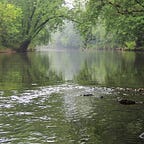DNR transplants nearly 1,500 mussels into Cedar River
Black sandshells grown in Austin’s East Side Lake past two years
AUSTIN, Minn. — Thursday, July 18, 2019 — Nearly 1,500 black sandshell mussels now can call the Cedar River “home.”
Today, a Minnesota Department of Natural Resources crew went to three sites on the Cedar River State Water Trail in Mower County to reintroduce black sandshell mussels they were growing in cages since May 2017 in Austin’s East Side Lake, part of the Cedar tributary Dobbins Creek.
DNR staff removed mussels — commonly called “clams” — Tuesday from the northwest corner of East Side Lake, tagged each one on Wednesday at their Lake City office and placed them in the Cedar River today, with each site getting about 490 mussels. The crew’s first site was near the DNR canoe-kayak access behind Austin’s Marcusen Park baseball stadium. The other two were south of the city in Austin and Lyle townships.
Relocation sites were chosen below Austin’s downtown dam to better enable the spread of black sandshell mussels along nearly 21 river miles of the Cedar River from that point to the next dam in Otranto, Iowa, a few miles south of the border.
Madeline Pletta, a mussel propagation biologist with the DNR’s Ecological and Water Resources division, has led the Cedar River mussels project, which launched in 2016.
“We have been very pleased with the black sandshell mussels’ growth through this project and are optimistic that they will thrive in the Cedar River and its tributaries, providing numerous benefits,” Pletta said.
Austin was known in the 1890s and early 1900s as “Pearl City” for its abundance of freshwater mussels, which became over-harvested by people for making buttons and jewelry as well as searching for the rare pearls found in some. Austin even once had a button-making factory connected to the local mussel population.
Reintroducing these mussels into historically occupied habitats from which they were removed or destroyed is a logical step toward improving their status in Minnesota as well as in Iowa, Pletta said. This effort also is likely to succeed today, she said, because water-quality improvements should allow them to become reestablished in the Cedar River’s Minnesota portion.
All mussels released in the Cedar River reintroduction sites have been marked with a numbered tag or another marking to distinguish them from any naturally recruited individuals and to assist with monitoring their growth and survival. Mussels’ reproductive strategy mainly involves using fish as hosts for their larval stage, allowing mussels to disperse wherever their host fish lives or swims to in a lake or river.
In Minnesota, it is illegal to collect live mussels and possess the shells of dead mussels that are state-listed species.
Freshwater mussels can live for several decades and, in some cases, a century or more. Freshwater mussels are important components of aquatic ecosystems by providing critical ecological services, such as providing structural habitat for other aquatic invertebrates, and food for fish, birds and mammals.
Mussels filter out suspended particles in water, including E. coli bacteria, and are considered “ecosystem engineers” because freshwater mussels modify aquatic habitat to make it more suitable for themselves and other organisms. They are sensitive particularly to habitat disturbance and pollution, making them excellent biological indicators of a river’s health.
Freshwater mussels occur throughout the world. Unfortunately, within the last 100 years, mussel communities have declined in abundance and diversity due to dam construction, stream channelization, water pollution and sedimentation, over harvesting and the recent introduction in some waterways of the exotic zebra mussel.
Mussels are identified as the most-imperiled group of animals in North America. In Minnesota, 28 of the state’s 50 species now are listed as either extirpated (destroyed), endangered, threatened or of special concern.
DNR surveys have revealed that rivers in Minnesota’s southern one-third no longer support their historical assemblages of mussel species. Black sandshells, for example, only were found in the form of dead shells in the Cedar River in Minnesota and its tributaries.
Notable exceptions in the survey, however, exist in the Cedar River Watershed with Otter and Rose creeks — tributaries of the Cedar River in Mower County. In Otter Creek, located east of Lyle, the DNR found 11 mussel species and, unlike most of the other streams surveyed, Otter seemed to support its historical complement of mussel species based on a lack of empty shells.
DNR’s Center for Aquatic Mollusk Programs (CAMP), based in Lake City along the Mississippi River, has been working to restore historic mussel species aggregations or clusters in the Cedar River and other select rivers and streams in Minnesota. CAMP biologists seek to reestablish mussel populations to delist state endangered and threatened species while engaging and informing the public about the importance of aquatic ecosystems and the unique role mussels play in benefiting people.
CAMP’s efforts involve surveying, monitoring, research, propagation and restoration. DNR has found species of mussels in the Cedar River but overall aims to restore six species in the Cedar River below Austin — black sandshell, mucket, elktoe, round pigtoe, flutedshell and monkeyface.
Cedar River Watershed District
In April 2007, state and local officials formed CRWD in response to the Cedar River Watershed’s top, worst-known floods occurring in 2000 and 2004. The CRWD’s top priorities are aimed at reducing flooding and improving water quality within the Cedar River Watershed.
